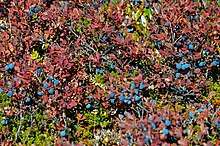Foraging
Foraging is the harvesting of wild organic material, such as plants and fungi, for food, souvenirs, or other purposes.
Still today, some communities in the world live as hunter-gatherers, and even in high-income countries, foraged berries and mushrooms remain as a part of the local cuisine.
Fruit and berries
| “ | Now when you pick a pawpaw, or a prickly pear And you prick a raw paw, next time beware Don't pick the prickly pear by the paw When you pick a pear, try to use the claw |
” |
—The Jungle Book | ||
Most biomes have some kind of fruits and vegetables. Many fruits and berries are edible, some are poisonous. There is no general rule to know which are edible, so learn to know the ones you are going to pick.
Regulation for berry-picking varies. Some suburban communities have abandoned fruit trees which can be harvested with the owner's consent; don't take risks, though.
Edible berries in temperate climate

- Bilberries and blueberries grow in temperate forest regions of North America, Europe and Asia.
- Lingonberries
- Cloudberries
- Raspberries
- Blackberries
- Strawberries
- Cranberries
- Elderberries
Wood
Trees hold high economic and ecological value, so cutting down trees, whether it be for a campfire, shelter or decoration, is usually prohibited, or at least very restricted. Even in a no man's land or with the landowner's permission, woodcutting requires informed judgment in how to minimize damage to the forest as a whole. Taking branches from the tree can cause fungal infections (risk varying by species and circumstances), likewise destroying the economic value.
Gathering of dead twigs on the ground is usually allowed.
Flowers
Wild flowers are usually picked for decoration, though they can have ceremonial purposes, and some are edible, too.
In temperate climate, the most diverse flowerbeds are usually found in livestock grazing grounds.
However, in many areas, wildflowers are highly protected, and collection requires a permit.
Fungi
Fungi can be great food – many species are very tasty, and in many parts of the world you can get them for free if you collect them yourself. On the other hand, their reputation for being poisonous is justified, too – quite a few are, and some of them can be deadly. There are no general means to distinguish these from edible ones. Never eat any mushroom you do not know well enough – and this includes knowing whether there are poisonous fungi that look similar, and how to distinguish the edible ones from the poisonous ones. When travelling, be especially sure you know any local doppelgangers (e.g., the death cap and destroying angels of Europe and North America are unknown in Southeast Asia).
There are also caveats for edible mushrooms. Most mushrooms are easily spoiled, so they have to be handled promptly and carefully. The first time you eat a specific mushroom species, eat only little, as not every edible species suits everybody. Most mushrooms aren't edible (or at least not tasty) until they are cooked. Some mushrooms are poisonous until treated in some specific way, often by cooking in abundant water then thrown away, repeatedly for some species.
The best way to learn to pick mushrooms is to have a local expert show you. There are also guidebooks. Learn to recognize only a couple of mushroom species at a time; forget about the other ones until you are confident in these, and then – perhaps next year – study a couple more. Some edible mushrooms are quite safe, as they, with some care, are easily distinguished from dangerous ones; others should not be picked until you are an expert, some perhaps not even then.
If you get ill after eating mushrooms it may be important to be able to tell your doctor about your mushroom dish. Some of the poisonous mushrooms do not give any early warning signs, so this applies also a few days afterwards.
Sea vegetables
Edible sea vegetation - seaweed, sea lettuce, nori or kelp - tends to be rich in minerals and vitamins and is considered delicacy in Asian countries. However this trend is spreading globally and edible seaweed can be found literally anywhere along the coast. Foraging takes place in the intertidal zone, typically at rocky shores. It is advisable to join a local guide for getting familiar with edible seaweed species. Care must be taken about slippery rocks to prevent an injury. Best avoided are places contaminated with sewage outlets or industrial activities. Sea vegetables can be consumed raw, cooked or dried.
Animals
Foraging includes the collection of butterflies and other small animals as decorative souvenirs, and animals such as clams, insects and larvae for eating. Do not harm endangered species. Also, common ones may be protected in places like national parks. Harvesting of reptile and bird eggs is typically illegal.
Pursuing larger or more mobile animals is described as hunting. See animal ethics for some other concerns.
Equipment
- A basket is the classic vessel for berry and mushroom picking. A plastic bucket can also be practical.
- Knife
- Berry-picking rake
- Mushroom knife (has a brush on the other end)
Stay safe
See poisonous plants and pests.
Foraged food can be infested with pathogens. For some pathogens washing it is enough; others require cooking. Also, water used for washing can be contaminated (see Water).
Respect
In most countries, foraging is restricted, if not prohibited. In nature reserves, the leave-no-trace principle might be enforced. The Nordic Right to access is permissive, but not all foraging is allowed even there.